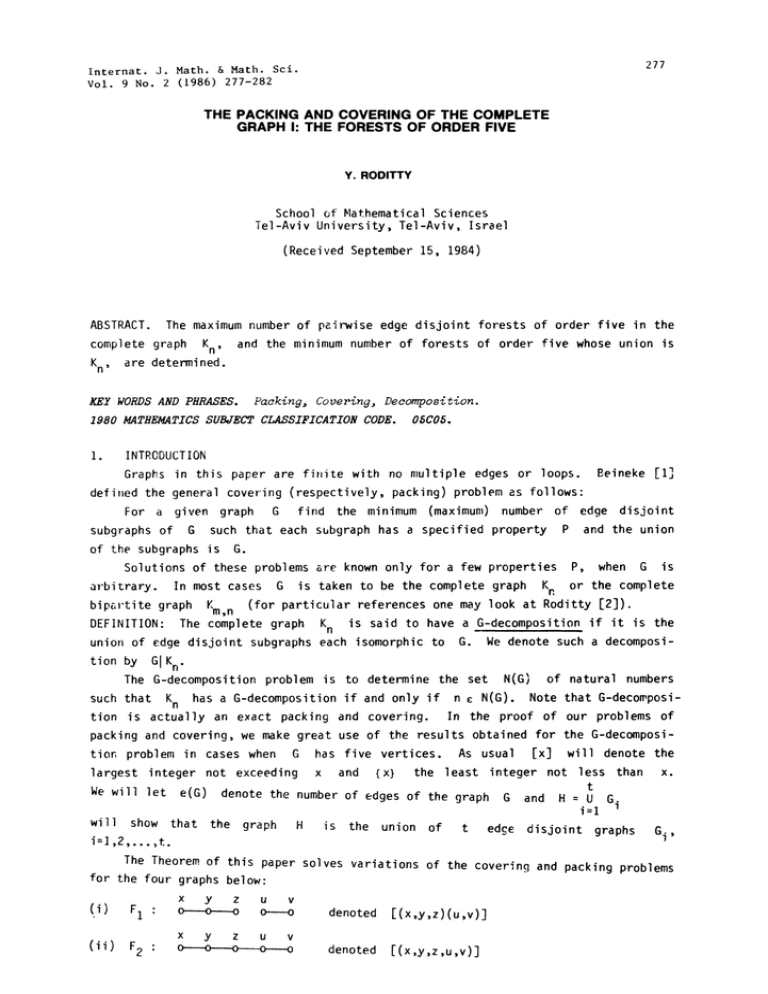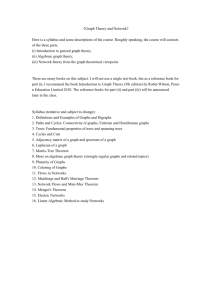Document 10507971
advertisement

277
Internat. J. Math. & Math. Sci.
Vol. 9 No. 2 (1986) 277-282
THE PACKING AND COVERING OF THE COMPLETE
GRAPH I: THE FORESTS OF ORDER FIVE
Y. RODITTY
School of Mathematical Sciences
Tel-Aviv University, Tel-Aviv, Israel
(Received September 15, 1984)
ABSTRACT.
The maximum number of pairwise edge disjoint forests of order five in the
complete graph K n, and the minimum number of forests of order five whose union is
K n, are determined.
KY WORDS AND PHRASES.
Packing, Covering, Decomposition.
1980 MATHEMATICS SUBJECT CLASSIFICATION CODE.
0C05.
INTRODUCTION
Graphs in this paper are fiite with no multiple edges or loops, leineke [I]
defined the general covering (respectively, packing) problem as follows"
For a given graph G find the minimum (maximum) number of edge disjoint
subgraphs of G such that each subgraph has a specified property P and the union
of the subgraphs is G.
Solutions of these problems are known only for a few properties P, when G is
arbitrary. In most cases G is taken to be the complete graph K n or the complete
may look at Roditty [2]).
bipartite graph
n (for particular references one
DEFINITION" The complete graph K n is said to have a GT.decomposition if it is the
union of edge disjoint subgraphs each isomorphic to G. We denote such a decomposition by G K nThe G-decomposition problem is to determine the set N(G) of natural numbers
N(G). Note that G-decomposisuch that K n has a G-decomposition if and only if n
tion is actually an exact packing and covering. In the proof of our problems of
packing and covering, we make great use of the results obtained for the G-decompositior, problem in cases when
G has five vertices. As usual [x] will denote the
largest integer not exceeding x and {x} the least integer not less than x.
We will let e(G) denote the number of edges of the graph G and H t
U G.
i.
Km,
i=I
will show that the graph H
is the union of
t edg disjoint graphs
Gi,
i=1,2
t.
The Theorem of this paper solves variations of the covering and
packing problems
for the four graphs below-
x
!i)
(ii)
F
F2
y
z
u
v
o-
o----o
x
u
y
z
denoted
[(x,y,z)(u,v)]
denoted
[(x,y,z,u,v)]
v
Y. RODITTY
278
denoted (x,y,z; u,v)
v
o
(iv)
F4
denoted (z; x,y,u,v)
y
u
Our theorem may now be states as THEOREM (Packing and Coveri,g).
et F be F 1, F 2 or F 3 and n > 5 or F be F 4 and n > 7 then
(i) The maximum number of edge disjoint graphs F which are suhgraphs of the
complete graph K n is
[e(Kn)/e(F)].
F whose union is the complete graph
(i i) The minimum number of graphs
Kn
is
{e(K n )/e(F)}.
PROOF OF THE THEOREM
We give a separate proof for each choice of F.
F 1" Froving the Theorem true for n_> 5 is a straightforward exercise.
al. [3] show that
2.
{nIn
N(FI)
Thus we have to consider only
n
O,l(mod 3)
3m + 2, m > 2.
n
>
Bermond et
(2.1)
6}
Observe that
(2.2)
U K2,3m U K 2 m > 2
be
and
can
has an Fl-decomposition. Since
by (2.1)
3
3
has an Fl-decomposidecomposed easily into two graphs F 1, it follows that
tion. Only K 2 in (2.2) is left non-packed. Hence, the Theorem is proved in this
case.
F 2" The proof will examine several cases depending on the value of n. The follow5,6,7,8m, and 8m + I for m 1.
ing table summarizes the cases n
K3m+2 K3m
K2,3m
K3m
n
8m,8m+1
mK2,
K2,3m
K2,
remains for covering
packing
(0,1,2,3,4);(1,3,0,4,2)
(0,I,2,3,4);(0,5,4,1,3) ;(0,4,2,5,3)
(0,I,2,3,4);(0,2,4,6,1);(1,3,5,0,4)
(1,4,5,6,0);(1,5,2,6,3)
F2 decomposition [4]
Table
(0,2);(1,4)
(0,3) ,(0,2),(1,5)
(0,3)
279
PACKING AND COVERING OF THE COMPLETE GRAPH
We still have to prove the theorem for the
r
k
8m + k
k
cases"
7
2
2.
Let
Ksm+2 Ksm U K2,8m U
(2.3)
K2
K2,8m
has an F2-decomposition. since
dec,.,.posed easily into two graphs F 2, it follows that
is left non-packed.
tion. Only K
2 in (2.3)
K= 3.
The graph
K8m
2mK2, 4 and K2,4 can be
K2,8m has an F2-decomposi-
Let
K8m+3 K8m+l U K2,8m+l
(2.4)
U K2
U
and
has
The graph
has an F2-deconposition
can be done in
an F2-decomposition as we saw above. This decomposition of
such a way that the edge (8m-I, 8m+2) is at one end of the
2 which includes it
and the point 8m-i is an end-point of that F 2. Thus we can replace the edge
(Sm-1,Sm+2) with the edge (Sm, 8m+2). Only the edges (8m,8m+l), (8m+l,8m+2),
(81r.-l,8m+2) now remain non-packed, and they can be included in one more F 2.
k =4.
K2,8m+1
K8m+1
K2,8m
K2,
K2,8m
K2,sm
Note that
The graph
K8m
F, as an
F2-decomposition. Now
K4,8m
and the
2K2, 4
(2.5)
K8m U K4,8m U K4.
K8m/4
U K4
2(2m-l)K2, 4 U 2K2, 4
U K4
s
carl be selected to be vertex disjoint.
Since
so does
We
to
need
show
only
that
4.
be packed by 5 F 2 graphs, leaving two non-packed edges.
Let
4) {1,2 8,a,b,c,d} V(K4) {a,b,c,d}
Then, the 5 graphs of the packing of
4 U K 4 are"
F2-decomposition,
2(2m-1)K2,
(2.6)
K2, 4
2K2, 4 U
has an
can
K4
V(2K2,
?K2,
(a,3,b,c,8);(l,a,d,7,c) ;(4,b,d,c,5) ;(a,c,6,d,8) ;(l,b,2,a,4).
The edges
k =5.
(d,5) and (a,b) are left non-packed.
Let
K8m+5 K8m+l U K4,8m U K4,1
U K4
(2.7)
has an F2-decomposition. In the case K
4 we saw that
U
two
leaving
non-packed
edges.
F2-packing
Let V(K 4)
{a,b,c,d} and
Denote the non-packed edges by (a,b)
and (Sm-l,d). We show that G
K4, U {(a,b),(8m-l,d)} has an F2-packing leaving
two non-packed edges. The F 2 of this packing is (8m-l,d,8m,a,b). The non-packed
are- (c,8m) and (8m,b).
The graph
K 4 has an
K8m+l
K4,sm
V(K8m+I) Z8m+l.
eges
Y. RODITTY
280
6.
k
Write
k8m+6 K8m U K6,8m U
K 6.
has and F2-decomposition. Observe that
In the case
The traph
Table
shows that K 6 has F 2
2 we saw that
k
packing leaving
three non-packed edges as required, and these three can be icluded in one more F 2.
7.
k
K6,8m 3K2,8m.
K8m
F21K2,8m.
Let
K8m+7 K8m+l U K6,8I
U K 7.
F21K6,8m,
The graph ’8m+] has an F2-decomposition, and
as was shown above. By
Table
we know that the graph
has an F2-packing leaving one non-packed edge.
lhe Theorem has now been proved for F 2 since all cases have been considered.
F 3- The proof will consider the same cases as the proof for F 2.
K
remains for covering
packing
n
(0,I,2;3,4);(1,4,0;2,3)
(0,i,2;3,4) (3,4,5;0,2) (0,3,1;4,5)
8nl,gm+l
(3,2,0;1,6);(5,4,i;2,3);(1,6,3;4,5)
(2,4,0;3,5) ;(1,5,6;2,4)
F 3 decomposition [4]
(1,3),(3,4)
(0,2) ,(0,4),(3,5)
(2,5)
Table 2
.e
now have to prove the theorem for the cases:
8m+k
n
k
2
7, I
k= 2.
has an F3-decomposition. Since
(2.3). The graph
can
be
into two F 3 graphs, it follows that
easily
decomposed
4
4
has an F3-decomposition. Only K 2 in (2.3) is left non-packed. Hence, the
Theorem is proved in this case.
k= 3.
U
has an F3-decomposition.
be as in (2.4).
Let
I.
the
shown
was
above.
Replace
edge
as
has an F3-decomposition
The graph
with the
(8m-4, 8m+2) which appears in some F 3 in the decomposition of
edge (8m,8m+2). Then the edges (8m-Z, 8m+2), (8m+2, 8m+l), (8m+l, 8m) remain
non-pdcked, but could be included in one additional F 3.
Let
K8m+2
2mK2,
K2,8m
and
be as in
K2,8m
K8m
K2,
K8m+3
K2,8m+l K2,8m K2,
K8m+l
K2,8m
K2,8m,
k=4.
has an F3-decomposition. Let, K4,8m U
be as in (2.5). The graph
Let
be as in (2.6). Since K2, 4 has an F3-decomposition, so does
K4
4
We show that 2K2, 4 U K 4 can be packed by five F 3 graphs, leaving two non-packed
edges.
K8m+4
K8m
2(2m-l)K2,
281
PACKING AND COVERING OF THE COMPLETE GRAPH
8,a,b,c,d}
{1,2
V(2K2,4)
Let
F3
Then the five graphs
{a;b,c,d}
V(K4)
and
are"
(c,6,d;7,8), (d,5,c;7,8), (4,a,c;d,b), (l,a,b;4,d), (a,3,b;1,2).
(a,2)
The ud(.]es
5,
k
(a,d) are !eft non-packed.
and
has an F3-decomposition. In the case
be as in (2.7). The graph
U K 4 has an F3-packing leavina two non-packed edges. Let
4 we saw that
k
Denote the non-packed edges by (a,d) and
{a,b,c,d} and
(a,8m-1)} is (b,8m,a;d,8m-1). The
U
{(a,d,),
F
in
(a,&,-]). The 3 graph
Let
K8m+l
K8m+5
K4,8m
V(Ksm+I) Z8m+1.
K4,
V(K4)
(d,8m)
edges
and
(c,8m)
remain non-packed.
are accomplished in the same ways as for F 2.
Once again all cases have been considered and the proof is complete for F 3.
iS is easy to see that the theorem does not hold for n
5 and n
6. For
K 7 the graphs F 4 of the packing are: (0;1,2,3,4), (1;2,3,4,5), (2;3,4,5,6),
(5;4,3,0,6), (6;0,1,3,4). The edge (3,4) is left non-packed. Hence, the theorem
is proved for n
7. For n=Sm, 8m+I we have an F4-decomposition [5,6]. Hence, we
again have to prove the theorem for the cases:
The
roofs for
6,7
k
F4:
8m + k,
n
k
k
7,
2
m
1.
2,
Let
k8m+2
K8m+1
U
K1,8m+1.
The graph
2m
is a star that can easily be packed by
k= 3.
Let
that
has an
F 4, leaving one nol-packed edged.
F4-decomposition.
KI,8m+1
K 3. The graph
has an F4-decompositior.. Let
Since the graph
can be decomposed into 2m stars F 4, it follows
also has an F4-decomposition. Let
and create a decompo-
K8m+3 K8m U K3,8m
3Ki,8m.
K8m+1
stars
U
K8m
K3,8m
Ki,8m
V(K3)={a,b,c},
K3,8m
(a ;x,y,z,u) ,(b;x,y,z,u),
includes the three stars
(c;x,y,z,u). Replace the edge (a,u) by (a,b), the edge (b,u) by (b,c), and
the edge (c,u) by (c,a). We did not spoil any star of the decomposition of
and the star (u;a,b,c) of three branches is left non-packed.
k =4.
has an F4-decomposition. Let
U K 4. The graph
U
Let
car.
be
decomposed into 2m stars F 4 so
,8m" The graph
and consider the subgraph
has an F4-decomposition. Let
4 of
{a,b,c,d} U {8m-1, 8m-2, 8m-3, 8m-4}.
whose vertices are given by
can be arranged in such a way that our
The F 4 decomposition of
4 is
made up of the four F 4 graphs (a;8m-1,8m-2,8m-3,8m-4), (b;8m-1,8m-2,8m-3,Sm-4),
(c;Sm-1,8m-2,8m-3,8m-4) and (d;8m-].8m-2,Sm-3,8m-4). Replace the edges (a,8m-1),
(b,Sm-1), (c,8m-I), (d,Sm-1) with the edges (a,c), (a,b), (b,c), (c,d), respectively
The edges (a,d) an( (b,d)
we now have a new F 4 graph, namely (Sm-1;a ,b ,c ,d
re the only one which remain non-packed.
sitin
of
K3,8m
which
K3,8m
K8m+4
K4,8m 4KI
K4,sm
Ksm
K8m
K4,8m
K1,8m
V(K4)={a,b,c,d},
V(K4, 4)
K4,8m
K4,8m
K4,
K4,
Y. RODITTY
282
5,
k
Let
K8m+5 K8m U K5,8m U K 5. As before K8m and K5,8m have
K 4 U KI, 4 so we can complete the proof in the same way
Now
4.
K5
Let
Let
K8m+6 K8m U K6,8m
U K 6.
F4-decompositions.
as
in
the case
k
The graphs
and
have F4-decompositions.
{Vl,V2,V3,V4,V5,V6}. Graph K 6 can be packed with the two F 4
{vl;v2,v3,v4,v 5} and {v2;v3,v4,v5,v6}. The induced graph on {v3,v4,v5,v 6} is K4.
Hence, we can complete the proof here as in the case k
4, leaving the edges
(v4,v non-packed. Those edges together with the non-packed edge (Vl,V
accomplish the proof of the theorem in this case.
7.
k
U
U K 7. The graphs
have F4-decompositions
and
Let
and we apply the F4-packing shown for K 7 at the beginning of this case.
This completes the proof of the theorem for F 4. F1
V(K6)
K8m
K6,8m
6)
(v5,v6),
K8m+7
6)
K8m
K7,8m
K8m
K7,8m
REFERENCES
1.
A Survey of Packing and Covering of Graphs. The Many Faces of
_Graph T.heory. Ed G. Chartrand and S. F. Kapoor. Berlin, Heidelberg’, New
B[INEKE, L. W.
York 1969, p
45.
Four
2.
RODITTY, Y.
3.
BERMOND, J. C., HUANG, C., ROSA, A. and SOTTEAU, D. Decomposition of Complete
Graphs into Isomorphic Subgraphs with Five Vertices, ARS Combin., I0
(1980) p. 211-254
4.
RAY-CHAUDHURI, D. K., and WILSON, R. M. The Existence of Resolvable Designs, A
Survey of Combinatorial Theory, (Ed. J. N. Srivastava et al.)
Packing and Covering of the Complete Graph with a Graph G of
Vertices or Less. J. Combin. Theory Ser. A, 34 (1983) No. 2, 231-243.
North-Holland, Amsterdam 1973, p. 361-376.
5.
TARSI, M.
Decomposition of Complete Multigraphs into Stars, Discrete Math.
(1979) p. 273-278.
6.
On Claw-Decomposition of Complete Graphs and Complete
Hiroshima Math. J. 5_ (1975) 33-42.
YAMOMOTO, Sumiyasu et al.
Digraphs.
26





